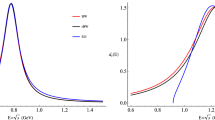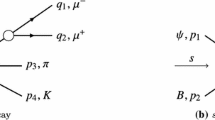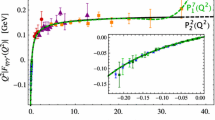Abstract
Strong decay probabilities are calculated using the Lorentz contracted wave functions of decay products, determined in the arbitrary dynamical scheme with the instantaneous interaction. It is shown that the decay width acquires an additional factor, defined by the contraction coefficient \(C_m(s)\), which for the two-body equal mass decays is \(C^2_m(s)= 4m^2/s\) , \(s= E^2\). The resulting decay widths are compared to experimental data, where, in particular the \(\rho (770),\rho (1450) \) decay data, require an additional 1/s dependence of the width to fit the data. Important consequences for the dynamics of hadron decays and scattering are shortly discussed.
Similar content being viewed by others
Data Availability Statement
This manuscript has no associated data or the data will not be deposited. [Authors’ comment: The numerical analysis of the experimental data on the \(\rho \) and \( \rho '\) decays was repeatedly and carefully done in [47,48,49] and discussed in detail in PDG [45] with the result that the energy dependence of decay probability is given by eq (14).Therefore for the present paper it is left only to derive eq (14) theoretically, which is actually done using Lorentz contraction and relativistic string decay theory.]
References
P.A.M. Dirac, Rev. Mod. Phys. 21, 392 (1949)
T.D. Newton, E.P. Wigner, Rev. Mod. Phys. 21, 400 (1949)
B.D. Keister, W. Polyzou, Adv. Nucl. Phys. 20, 225 (1991)
W. Polyzou, arXiv: 0908.1441
R.N. Faustov, Ann. Phys. (NY) 78, 176 (1973)
A.F. Krutov, V.E. Troitsky, Phys. Rev. C 65, 045501 (2002). arXiv:hep-ph/0210046
A.F. Krutov, V.E. Troitsky, Phys. Rev. C 68, 018561 (2003). arXiv:hep-ph/0307217
A.F. Krutov, R.G. Polezhaev, V.E. Troitsky, Phys. Rev. D 93, 036007 (2016). arXiv:1602.00907
A.F. Krutov, R.G. Polezhaev, V.E. Troitsky, Phys. Rev. D 97, 033007 (2018). arXiv:1801.01458
A.L. Licht, A. Pagnamenta, Phys. Rev. D 2(1150), 1156 (1970)
M. Yärvinen, Phys. Rev. D 70, 065014 (2004)
M. Yärvinen, Phys. Rev. D 71, 085006 (2005)
D. Dietrich, P. Hoyer, M. Yärvinen, Phys. Rev. D 85, 105016 (2012)
YuA. Simonov, Phys. Rev. D 91, 065001 (2015). arxiv: 1409.4964 [hep-ph]
H.G. Dosch, YuA Simonov, Phys. Lett. B 205, 339 (1988)
YuA Simonov, Phys. Rev. D 99, 056012 (2019). arXiv: 1804.08946 [hep-ph]
YuA Simonov, Nucl. Phys. B 307, 512 (1988)
YuA Simonov, Phys. Lett. B 226, 151 (1989)
YuA Simonov, Phys. Lett. B 228, 413 (1989)
YuA Simonov, J.A. Tjon, Ann. Phys. 300, 54 (2002)
YuA. Simonov, Phys. Rev D 90, 013013 (2014). arXiv: 1402.2162 [hep-ph]
YuA Simonov, Phys. Rev. D 88, 025028 (2013). arXiv:1303.4952 [hep-ph]
YuA Simonov, Phys. Rev. D 99, 096025 (2019). arXiv:1902.05364
H.A. Lorentz, Encyclopaedie der Mathematischen Wissenschaften (Band V, art 13,14 (Teubner, Leipzig, 1904)
W. Pauli, Theory of Relativity (Pergamon Press, N.Y., 1958)
Yu. A. Simonov, Hadron form factors with boost-corrected wave functions, arXiv:2004.11466 [hep-ph]
Yu. A. Simonov, Proton and neutron form factors with quark orbital momenta, arXiv:2010.12666
Yu.A. Simonov, Phys. Rev. D 84, 065013 (2011). arXiv:1103.4028 [hep-ph]
YuA Simonov, Phys. Atom. Nucl. 71, 1048 (2008)
L. Micu, Nucl. Phys. B 10, 521 (1969)
A. Le Yaouanc, L. Olivier, O. Pene, J. Raynal, Phys. Rev. D 8, 2223 (1973)
A. Le Yaouanc, L. Olivier, O. Pene, J. Raynal, Phys. Rev. D 9, 1415 (1974)
A. Le Yaouanc, L. Olivier, O. Pene, J. Raynal, Phys. Rev. D 11, 1272 (1975)
A. Le Yaouanc, L. Olivier, O. Pene, J. Raynal, Phys. Rev. D 21, 182 (1980)
R. Kokoski, N. Isgur, Phys. Rev. D 35, 907 (1987)
R. Konyuk, N. Isgur, Phys. Rev. D 21, 1868 (1980)
E.S. Ackleh, T. Barnes, E.S. Swanson, Phys. Rev. D 54, 6811 (1996)
H. Blundell, S. Godfrey, Phys. Rev. D 53, 3700 (1996)
S. Capstick, W. Roberts, Phys. Rev. D 47, 1994 (1993)
T. Barnes; arXiv:hep-ph/0311102
T. Barnes, S. Godfrey, E.S. Swanson, Phys. Rev. D 72, 054026 (2005)
Yu. A. Simonov, Phys. At. Nucl. 66, 2045 (2003). arXiv:hep-ph/0211410 (2002)
M.S. Lukashov, YuA Simonov, Phys. Rev. D 101, 094028 (2020)
A. M. Badalian, M. S. Lukashov, Yu. A. Simonov. arXiv:2001.07113 [hep-ph]
M. Tanabashi et al. (Particle Data Group), Phys. Rev.D 98, 030001 (2018) and 2019 update
G.J. Gounaris, J.J. Sakurai, Phys. Rev. Lett. 21, 244 (1968)
M. N. Achasov et al. (SND Collaboration); arXiv:2004.00263 [hep-ex]
M. Ablikim et al., BES III Collaboration. Phys. Lett. B 753, 629 (2016)
J. P. Lees (BaBaR Collaboration), Phys. Rev. D 86, 032013 (2012). arXiv:1205.2228
Yu. A. Simonov, Phys. Atom. Nucl. 67, 1027 (2004). arXiv:hep-ph/030528
M. Gell-Mann, R.L. Oakes, B. Renner, Phys. Rev. 175, 2195 (1968)
Acknowledgements
The author is grateful to A. M. Badalian for useful discussions and advices. This work is supported by the Russian Science Foundation (RSF) in the framework of the scientific project, Grant 16-12-10414.
Author information
Authors and Affiliations
Corresponding author
Additional information
Communicated by Reinhard Alkofer
Appendices
Appendix A1: The L dependence of the decay matrix element
Starting from the (8) one can write the decay matrix element \(J_L(p)\), when the string extending from \(x_Q\) to \(x_{{\bar{Q}}}\) decays at point x into two strings with the appropriate wave functions \(\psi _2,\psi _3\)
Going over into the momentum space one obtains
Here \(\Psi _1^L(p) ~ p^L\) and for \(L=1\) one obtains the linear dependence on p. One should stress the important property of (9) and (A1.1) - both hadrons 2 and 3 have the same internal momentum q which leads finally to the effects of Lorentz contraction in the decay width, while in absence of string breaking at the point x both momenta q and \(q'\) in \(\psi _2(q)\) and \(\psi _3(q')\) are independent, they are integrated separately and no contraction effects are visible.
Appendix A2. The pion wave function
The problem of chiral wave functions was studied in a series of papers during last 20 years (see [50] and refs therein) using the Chiral Confining Lagrangian (CCL) where CSB is directly connected with confinement and all known chiral relations like GMOR [51] are directly deduced from CCL. The main outcome of the CCL for the pion Green’s function in [50] is that it can be expanded as a series of \(q{\bar{q}}\) wave functions \((\phi _n(x)\) while the pion mass is strongly shifted from the set \(m_n\) and is defined by the vacuum condensate \(\langle {\bar{q}} q\rangle \) as it is seen in GMOR relations. As a result in [50] the pion Green’s function was obtained in the form \( G(k)= \frac{\Psi (k)}{(k^2 + m_{\pi }^2) \Phi (k)}\), where both \(\Psi (k),\Phi (k)\) are expressed via \(\phi _n(x)\) only and the lowest eigenfunction \(\phi _0(x)\) gives the dominant contribution. In a similar way the basic chiral parameters \(\langle {\bar{q}} q \rangle \) and \(f_\pi \) are expressed in [50] as a sum of \(\phi _n\) contributions with the dominant role of \(\phi _0\). Summarizing one can conclude that the pion is well described by the standard \(q {\bar{q}}\) nonchiral wave functions except for its mass which is strongly decreased by the vacuum effects.
Rights and permissions
About this article
Cite this article
Simonov, Y.A. Strong decays with the boost-corrected wave functions. Eur. Phys. J. A 57, 127 (2021). https://doi.org/10.1140/epja/s10050-021-00445-4
Received:
Accepted:
Published:
DOI: https://doi.org/10.1140/epja/s10050-021-00445-4




